Inside\Within is a constantly updating web archive devoted to physically exploring the creative spaces of Chicago's emerging and established artists.
Support for this project was provided by The Propeller Fund, a joint administrated grant from Threewalls and Gallery 400 at The University of Illinois at Chicago.

Search using the field below:
Or display posts from these tags:
3D printing 3D scanning 65 Grand 7/3 Split 8550 Ohio 96 ACRES A+D Gallery ACRE animation Art Institute of Chicago Arts Incubator Arts of Life audio blogging Brain Frame CAKE Carrie Secrist Gallery casting ceramics Chicago Artist Writers Chicago Artists Coalition Chicago Cultural Center Cleve Carney Art Gallery Clutch Gallery Cobalt Studio Coco River Fudge Street collage collection Columbia College Chicago Comfort Station comics conceptual art Contemporary Art Daily Corbett vs. Dempsey Creative Capital DCASE DePaul University design Devening Projects digital art Dock 6 Document drawing Duke University dye Elmhurst Art Museum EXPO Chicago Faber&Faber fashion fiber Field Museum film found objects GIF Graham Foundation graphic design Harold Washington College Hatch Hyde Park Art Center illustration Image File Press Imagists Important Projects ink installation International Museum of Surgical Science Iran Jane-Addams Hull House Museum jewelry Joan Flasch Artist's Book Collection Johalla Projects Julius Caesar Kavi Gupta Links Hall Lloyd Dobler LVL3 Mana Contemporary metalwork Millennium Park Minneapolis College of Art and Design Monique Meloche Museum of Contemporary Art Chicago (MCA) Museum of Contemporary Art Detroit (MOCAD) Museum of Contemporary Photography (MoCP) National Museum of Mexican Art (NMMA) National Resources Defense Council New Capital Northeastern Illinois University Northwestern University Ox-Bow painting paper mache Peanut Gallery peformance Peregrine Program performance photography PLHK poetry portraiture printmaking public art Public Collectors publications Renaissance Society risograph rituals Roman Susan Roots&Culture SAIC screen printing sculpture Sector 2337 Shane Campbell Silver Galleon Press Skowhegan Slow Smart Museum Soberscove Press social practice South of the Tracks Storefront SUB-MISSION Tan n' Loose Temporary Services Terrain Terrain Biennial text-based textile textiles The Banff Centre The Bindery Projects The Cultural Center The Franklin The Hills The Luminary The Packing Plant The Poetry Foundation The Poor Farm The School of the Art Institute of Chicago (SAIC) Threewalls Tracers Trinity College Trubble Club University of Chicago University of Illinois at Chicago (UIC) University of South Florida at Tampa Valerie Carberry Vermont Studio Center video weaving Western Exhibitions wood carving woodwork Yellow Book Yollocalli Arts Reach zinesInside\Within is produced in Chicago, IL.
Get in touch:
contactinsidewithin@gmail.com
Zachary Cahill’s Fluorescent Propaganda

Zachary’s studio is one of many sites that has housed the USSA, a series started in 2009 that imagines our society as controlled by a Soviet regime. Through several interrelated projects he has examined the nation’s infrastructure, creating a orphanage, wellness center, and most recently a state church titled the Assembly. Inspired by Marvel comics, Zachary has formed a tetrad of alien gods that serve as the base of the religion, reimagining the letters U, S, S, A as a message from another planet rather than the title of a communist public.
I\W: Can you provide a concise background of your USSA project? How does the project serve as a jumping off point for your practice?
ZC: Paying attention to the thing you aren’t paying attention to is an artistic strategy I have tried to value. Back in 2009 when I returned from a residency at the Banff Centre in Canada, I wrote a Facebook post that stated I was: “Back in the USSA.” I had just finished up a year-long project about the complex Soviet historical figure, Felix Dzerzhinsky, and I was at a bit a loss for where to go next. I thought to myself that maybe there was a project inside those words—those four letters. It was then, I guess, the USSA was born.
I didn’t at first know what to make of the ridiculous way Republicans were referring to the then relatively new president, Barack Obama, as a communist. I was thinking that I lived in Chicago, he is from Chicago, May Day started here, and bears are a really important mascot in this city and Russia. Maybe those idiotic Republicans were more right than they knew, and that Chicago (Obama’s hometown) was some sort of hidden Soviet enclave. It was a hypothetical proposal. I just wanted to accept their ludicrous argument and play it out. The letters of the project never really meant anything, but I thought of it as a hopeful gesture in a way, one that proposed that maybe the USSA embodied the best of both communist and capitalist worlds. Eventually I began to imagine that if one were to build a country, you’d need infrastructure. You would need hospitals, you’d need schools, etc.
Each USSA project would be a thematically driven infrastructure proposal. As I kept going, it snowballed and gained momentum and significance. I started with an orphanage at Threewalls, created a gift shop at the Chicago Cultural Center, a wellness center which spanned multiple exhibition venues (Smart Museum, MCA Chicago, and the Berlin Biennale), a State-Farm down state at Illinois Wesleyan University, and currently have moved on to a state church, which I call the Assembly. All of these aspects of the USSA start building on each other, informing each other. The momentum accumulated from each iteration was something I hadn’t anticipated, but I savor now. Still it can be tricky in some ways because it means that audiences might not “get it” if they haven’t been following along. My hope of course is that each exhibition stands on its own terms and builds on the larger novelistic structure that I am trying to unfold.
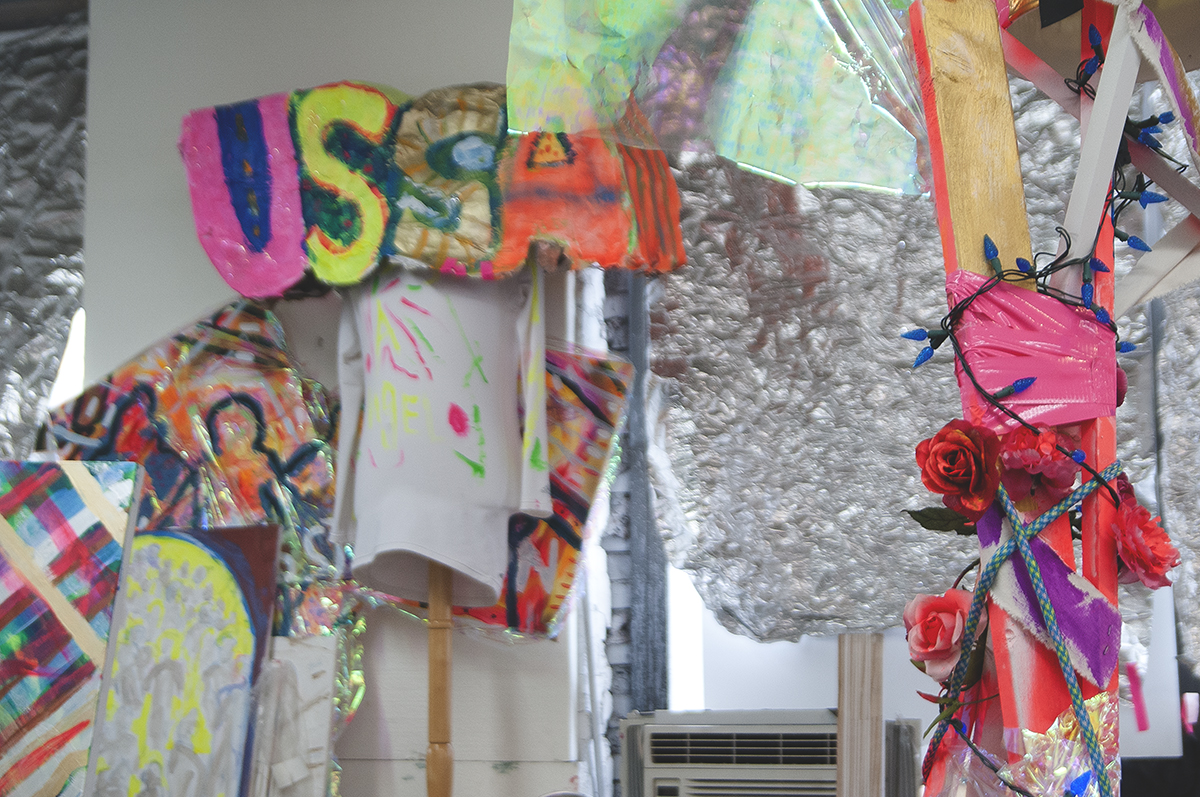
How have the letters gained significance throughout the course of your project?
I am extremely lucky to have had the support I have gotten over the years for the USSA. The letters and the project has engaged people and challenged them and in the sense that they have been a useful provocation; twisting the reception of the work in unexpected ways. All stuff I am thankful for. Still, at times the letters can be a hang up for some people. I am not crying over it, but it can rub certain viewers the wrong way. What can I say, my work is not for everybody. In fact, I am not sure I’d want to make art for “everybody,” (What kind of limp amorphous blob would that be anyways?) But I digress, some folks think the letters are overly political/partisan and grouse over the “specter of communism”… that sort of thing. For others, the letters are too kitschy, in what they see as nostalgia and fetish-ization of all things Soviet. But then I thought, maybe those skeptics all have it wrong, that the letters aren’t what they think they are. That maybe the letters aren’t letters at all. In the Assembly, I have been thinking of the letters as crop circles. A message from an alien culture. The letters U.S.S.A. appear in exhibitions, but people’s associations may have been wrong. I mean they aren’t actually wrong, but that they could be wrong, that I myself could be wrong, that slant opened up a new direction for the work. It helped me conceive the possibility of a plot twist for the project. What we all thought we understood, this geo-political thing (a mash-up between the USA and the USSR), was really these creatures from outer space. Their heads just happened to look like U’s, S’s, and A’s. Letters are inherently abstract and I wondered what if we didn’t take the letters literally but more pictorially, what would that do. I have been playing around with that idea in this body of work.
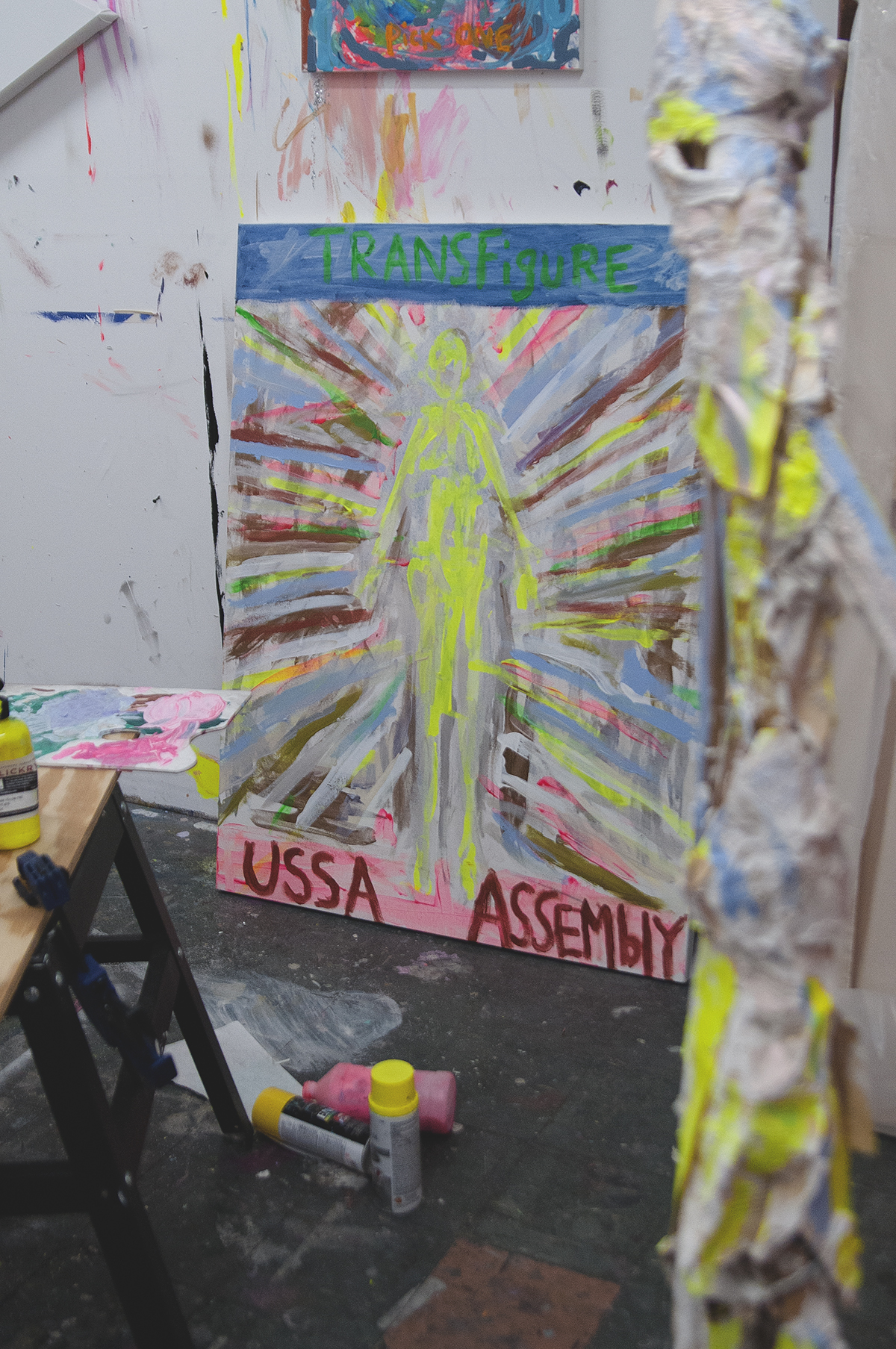
So the letters are actually messages from another dimension?
Yeah. I have been thinking about the Assembly as a form of religion, and creating these alien gods. During the course of the project I have been really inspired by Marvel comics, especially Jack Kirby, who was one of the originators of all of those characters like Thor, X-Men, the Avengers, all those characters that kind of dominate our popular culture at the moment. Though his comics, Jack Kirby championed a notion that gods were an advanced alien species that came to Earth eons ago and were worshipped by human beings. I am trying to create a similar mythology (albeit with a geo-political inflection), and the aliens show up in a lot of the work right now.
For my show, USSA Love Chapel, at Regina Rex this past Spring, these alien/gods were very present. They will also be a part of the show coming up at Anastasia Tinari Projects in September, the exhibition is entitled, USSA Sanctuary. The two shows are like outposts of the larger Assembly. All of these different church-sounding exhibitions are still part of the Assembly, but hopefully can also exist as their own thing too. I started creating drawings of the cathedral and this diamond shape (or square within a square) is now kind of a fixture—my religious symbol, if you will. The four alien gods open up this expanding structure-like thing (the symbol) and, in my admittedly wacky way of thinking, it eventually develops and builds into a cathedral.

How else have Marvel comics influenced your current work?
It is a familiar story I suppose. Little kids and super-heroes…I wanted to be like them and I wanted to draw them. Comics were a special kind of magic for me, they still are. It probably has something to do with the combination of the arts of drawing and writing, the visuals of letters floating in space, and the fantastic worlds that artists create in comics. There is occasionally brilliant storytelling in the genre. It’s also the seriality, how one things leads to the next, the anticipation of waiting around for the next issue, and the covert way that politics can slip in. All of these things are influencing my current work and interest in comics. My partner Holly pointed out how my interest in comics we readily apparent in all my work a few years ago. Funny, I didn’t see it at first. Now I see it everywhere.

Your exhibition at Regina Rex included a 30-page writing you titled the Epistles. Do you think you could have fully experienced that exhibition, or your larger practice, without reading this text?
I think yes and no. A lot of people who went to the Love Chapel commented on the bright colors and the glitter. The Epistles for me were the heart of that exhibition. If you were willing to take the time to read them, you would see the connection between those bright paintings and the writing about heaven and the afterlife. For me the two (the Epistles and the paintings and sculptures) are really tied together for the show in New York. Now, I feel like I might have done what I needed to do with that set of writings and they probably won’t be in the Sanctuary.
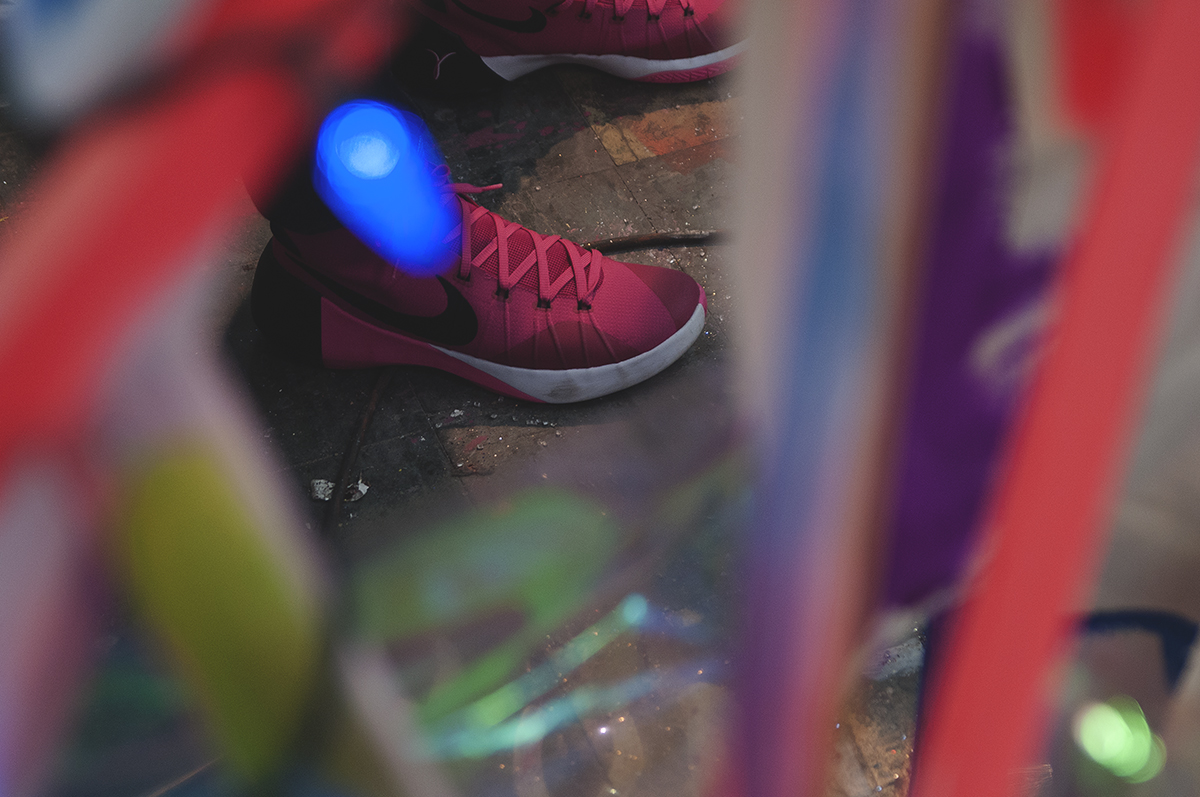
To get back to the specific question of reading and art viewing, I personally like to go out and look at exhibitions, but I also like to lay on my couch and read. You know, be a lazy viewer. Or to put in another way: I like having those two things work together and don’t feel like the experience of art needs to end in a public setting like a museum of a gallery. I read this quote recently by David Markson, a writer who wrote experimental novels through the accumulation and arrangement of cultural factoids and quotations. Markson was quoting Schopenhauer who said something like, ‘reading is thinking with someone else’s mind instead of one’s own,’ which I think is true. Reading is super-weird thing we do, if you stop and think about it. It is you, thinking, while simultaneously listening to someone else’s thoughts—all happening in the same skull.
Whose perspective are the Assembly paintings and sculptures made from? Are they created from the perspective of the USSA’s citizens or your own?
The second one. In terms of belief, maybe it is like Michelangelo carving sculptures of saints. He was making his saints, and I am making mine. Not that I am comparing myself to that heavy duty art giant, but one similarity maybe is his works connection to propaganda. I have a longstanding interest in questions relating to art and propaganda. Etymologically, the word propaganda derives from the word “to propagate,” and what art doesn’t want to be spread to other people? The word didn’t carry such horrible baggage until the 20th century. What now people label as propaganda might have been really great art for the people of a certain persuasion. Like Michelangelo’s Sistine Chapel was a tour de force to get people interested and overwhelmed by the Catholic faith. I mean we talk about the Sistine Chapel as “Great Work of Art” but it is so clearly Catholic Propaganda. The power of art was used to inspire awe and convert people.
With the Assembly project I want to offer a meta-religion. No, that’s not right exactly… maybe a set of proposals for a new type of religious relationship to the world. Religion can be such a bummer. Full of arcane rules, holier-than-thou attitudes and intolerant judgements. Much of the time religious leaders are frauds and do horrible things like fight wars and kill people, enrich themselves in the name of this god or that god. It’s not that all those things don’t play out throughout the rest of our social institutions, they do. Politicians can be frauds, military folks kill people by definition, business people can be crooks, but religions also espouse things like love, enlightenment, care for one’s neighbor—all that and the art can be cool, redeemable maybe, and can be put towards other ends. It’s all probably hubris on my part to dream up my own religion, and probably it is offensive to many people. In any case, I see religion as a fertile ground to venture into the political, collective imaginaries, human experience of the divine, ecstasy, and the unknown.
Can you talk about your use of séances in your practice?
I have been conducting them since 2009. Usually with shows, usually at midnight. It is a really important part of my practice that not everyone sees, which I am OK with because I don’t expect a lot of people to show up at midnight for an event. However the people that do, get something out of it, or at least I hope they do. I don’t mean that it is seedy, but I have always thought of it as the underbelly of the exhibition— the dark side. It is literally dark out when they happen. As an artist I tend to be really demanding, and ask a lot from my viewer. For people who really want to know my larger practice, it helps to experience a séance. That’s about all I can really say. I tend not to share much about the particulars in regards to the séances. The only other thing I’d share is that they are not your grandparents séance.
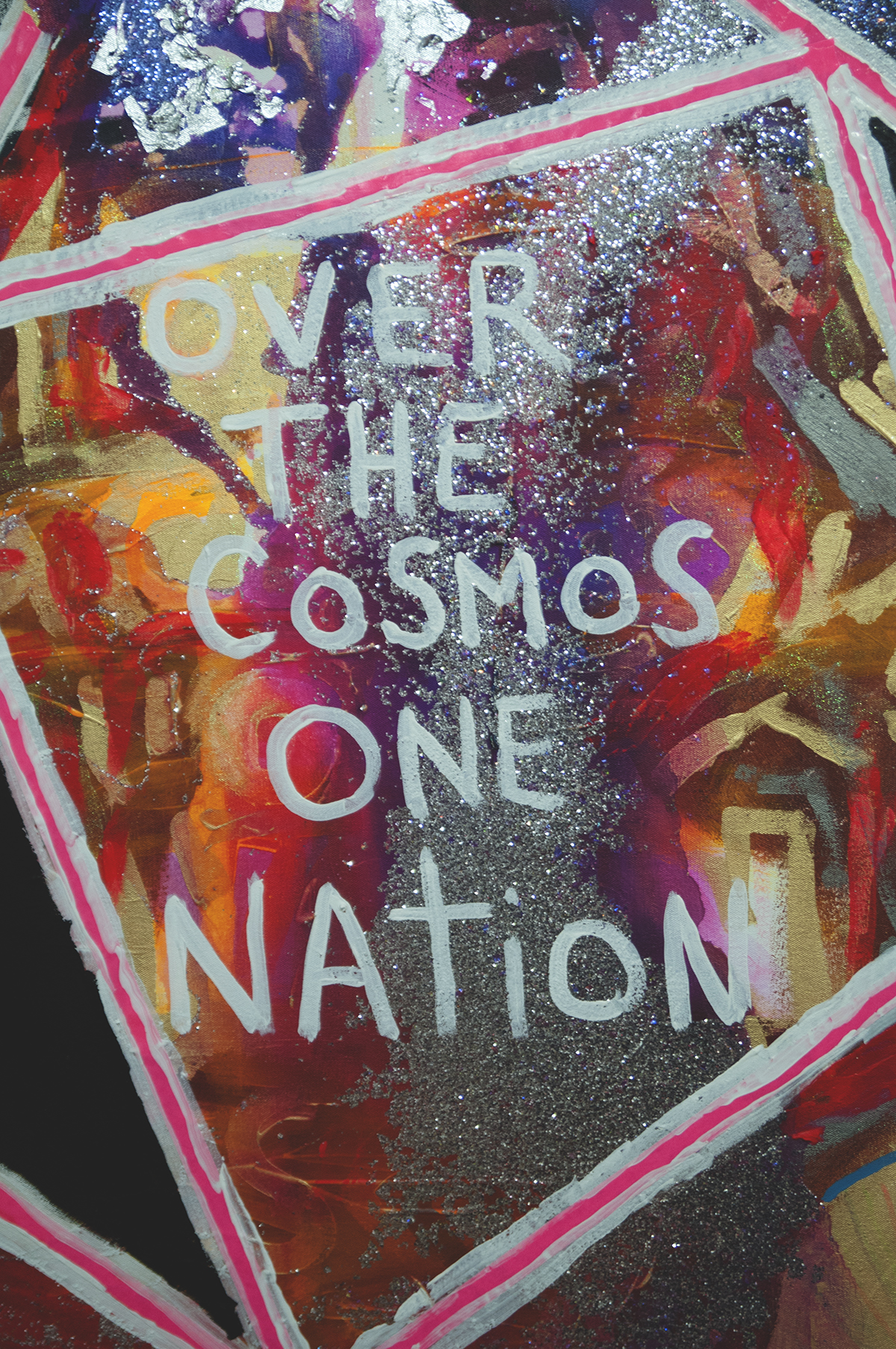
Is the Assembly focusing on the positive side of religion? Is it all good?
There is a slogan in one of the Assembly paintings: Over The Cosmos One Nation. When I made it I thought it had a positive connotation such as: no more borders. But now I feel like that it could be the kind of painting that Darth Vader might want to hang in the Deathstar. One nation. Which is a bit scary, no? For me there is always a tension that serves the work between the ugly and the beautiful, hope and despair, violence and serenity, pairs of opposites and contradictions.
Is art as therapy still a topic you are working with within your practice?
There is a continuum from where it started in my Wellness Center project to the religious thing I’m working on now that wasn’t super intentional. Certainly the Epistles I wrote are still along that line. I believe in the power of art to heal, and not just in terms of individual but also as a culture. It is true that art has been a lapdog of power for most of its history. It is kind of gross really. People use art for their own machinations. Whether it is the church or hedge fund manager trying to launder their money, the powerful love to trade in art. But I don’t think that is the only relationship to art that exists, in fact that is pretty different than how most people experience art.
For instance, a pop song could be there for somebody when they really need it; when least expect it. Maybe a painting can connect you to a loved one, or just serve as a reminder that there is another person out in the world that cares about the weird way two colors can hang together in a small corner of a still life. Or, one might read a sentence that shifts the way you go about your day, you go about your day with a sentence buzzing in your ear. I guess I am a sucker for art. Especially the ethos of art from the 60’s and 70’s. Intelligent fun is what inspires me from that period and there was a social consciousness to the work that I admire.
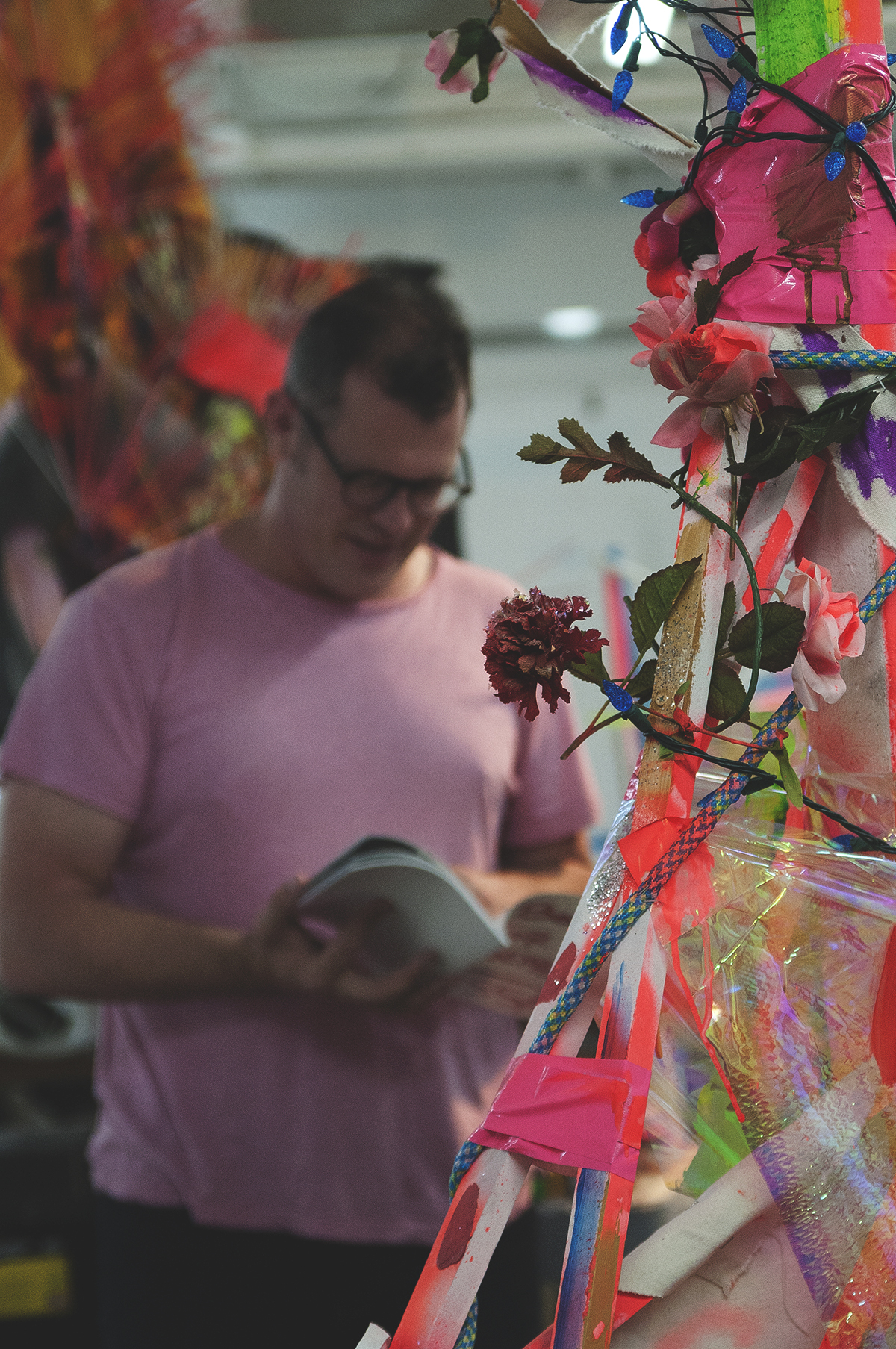
I\W: Why has painting come to stay in your practice?
At first I kind of thought of the introduction of painting into my practice as a conceptual conceit for the Wellness Center. Then I realized that I kind of liked how the paintings turned out and I enjoyed making them. I don’t self-identify as a capital “P” painter, maybe I am more of a little “p” painter? (is that a thing? Little “p” painting?) I guess I don’t suffer the “burden of the history of painting.” I have enough challenges in my life.
Painting is a way for me to create images, a way that I feel tangibly connected to an image. My hand and body goes into it, as well as my ideas and emotions, and painting registers the speed of an artist’s thinking/feelings pretty efficiently—no buffering, no downloading. I can do all of the stuff that I was trying to do in video, installation, and performance, in a painting without a lot of clunky technical apparatus to deal with. That was a big realization for me. Also, no one can turn a painting off. If you have ever made video work, you know that sometimes people can forget to turn your piece on in the gallery, and then the art doesn’t exist. Painting doesn’t have that problem. But, I guess people could turn off the lights…


